Exploring OLED Technology in Samsung's 4K Offerings
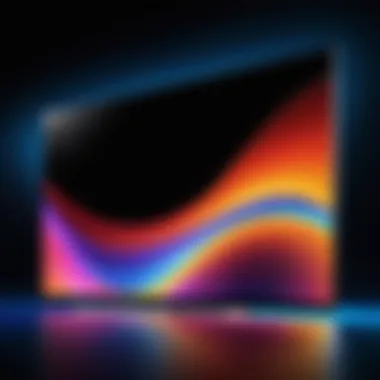

Intro
The emergence of OLED technology has significantly reshaped the landscape of display technology. Samsung, a dominant player in the electronics market, has leveraged this advancement in its 4K television offerings to enhance visual experiences. This article will navigate through the intricate features, performance metrics, and consumer implications of Samsung's OLED displays.
As we delve deeper, we will uncover how OLED technology not only elevates picture quality but also addresses energy efficiency concerns, making it a compelling choice for modern households. The journey will provide insights into Samsung's unique approach in comparison to its competitors, positioning it as a frontrunner in an increasingly competitive arena.
Let’s begin with an overview of the products that utilize this remarkable technology.
Foreword to OLED Technology
The introduction of OLED technology marks a significant advancement in display innovation. Understanding this technology is essential for grasping how Samsung incorporates it into their 4K offerings. OLED stands for Organic Light Emitting Diode. It represents a shift away from traditional LCD technologies, allowing for remarkable enhancements in color fidelity, contrast ratios, and energy efficiency.
Definition and Fundamentals of OLED
At its core, OLED technology uses organic compounds that emit light when an electric current passes through them. This fundamental operation allows each pixel to produce its own light, eliminating the need for a backlight. As a result, OLED displays can achieve deeper blacks because the individual pixels can be turned off entirely. Compared to LCD screens, which rely on a backlight that can lead to light leakage and reduced contrast, OLEDs provide a clearly superior viewing experience.
Another important aspect is the flexibility of OLED panels. They can be manufactured on various substrates, which allows for innovative designs like curved and thin displays. This adaptability makes OLEDs not only practical but also highly sought after in the premium display market.
Evolution of Display Technologies
Display technologies have evolved rapidly over the past few decades. Initially dominated by CRTs, the industry saw a significant transition to LCDs. These new LCDs brought better energy efficiency and thinner designs. However, with the introduction of OLED, a new era began. OLED technology is often considered a natural progression, delivering all the benefits of LCD with additional enhancements.
Each generation of OLED has improved upon the last in terms of brightness, color accuracy, and response times. Moreover, developments in manufacturing processes have made OLED screens more affordable over time, broadening their market appeal. The intersection of OLED technology with 4K resolution presents both opportunities and challenges for manufacturers like Samsung, who aim to deliver superior visual experiences in their television offerings.
Samsung's Approach to OLED
Samsung's strategy towards OLED technology reflects its commitment to innovation and excellence in the realm of display manufacturing. This section elaborates on how the company has positioned itself as a leader in the OLED market by incorporating advanced engineering practices and market strategies that resonate with consumers.
Innovation in Display Manufacturing
The foundation of Samsung's success in OLED technology lies in its groundbreaking innovation in display manufacturing processes. Samsung has invested heavily in research and development focused on enhancing OLED production capabilities. The company has transitioned from traditional manufacturing methods to advanced techniques like Quantum Dot technology, leading to significant improvements in color accuracy and brightness levels. This not only elevates visual quality but also extends the usability of the displays in various lighting conditions.
Furthermore, Samsung incorporates modular designs in its manufacturing. This flexibility allows for a range of screen sizes and resolutions to meet consumer preferences and needs. The integration of automated production lines ensures consistency and quality control, reducing human error and boosting productivity. An important aspect of this innovation is the focus on upscaling capabilities, where lower resolution content can be enhanced to match the 4K standard, preserving the visual integrity across different types of media.
Strategic Positioning in the Market
Samsung's strategic positioning in the OLED market demonstrates its understanding of both consumer needs and competitive dynamics. The company employs a multi-faceted approach that addresses various market segments. By offering diverse OLED models, Samsung caters to a wide range of price points, thereby appealing to both high-end consumers and those seeking more affordable options.
Additionally, Samsung has established partnerships with various content providers, allowing it to deliver an optimized viewing experience. These partnerships ensure that content available on Samsung's 4K OLED TVs fully utilizes the advanced features of the displays. The marketing campaign for these products is designed to emphasize these unique selling points, particularly focusing on superior visual fidelity and enhanced user experiences.
In summation, Samsung's approach to OLED technology is not just about manufacturing superior products; it encompasses holistic strategies aimed at market leadership. The innovations in display manufacturing coupled with strategic market positioning enables Samsung to remain competitive in a rapidly evolving technological landscape.
Comparative Analysis of Samsung's 4K OLED Models
The comparative analysis of Samsung's 4K OLED models is fundamental to this discussion. It allows us to understand how these products stack up against each other and how they perform relative to competitors in the market. Analyzing specific features, performance metrics, and overall user experience ensures that potential buyers make informed decisions. This scrutiny highlights Samsung's strategic direction in OLED technology, which is crucial for both enthusiasts and professionals in the tech field.
Technical Specifications


In any electronics market, understanding technical specifications is essential. Samsung's 4K OLED models feature differing specifications that cater to various needs. The resolution is consistently outstanding, offering a 3840 x 2160 pixel count that delivers clarity.
Key components include:
- Panel Technology: Samsung uses Quantum Dot OLED technology, enhancing color volume and brightness.
- HDR Support: Many models feature HDR10+ support, improving dynamic range.
- Refresh Rates: They generally support up to 120Hz, which is crucial for fast-moving content like gaming or sports.
- Connectivity Options: HDMI 2.1 ports are standard in newer models, supporting higher resolutions and refresh rates.
This attention to detail ensures that consumers have the best technology available at their fingertips.
Visual Performance Metrics
Visual performance metrics are a critical aspect of any OLED display. Samsung's 4K OLED televisions excel in several areas that enhance the viewing experience:
- Color Accuracy: These models are known for their ability to reproduce colors accurately. This is especially important for professionals who rely on precise color grading.
- Contrast Ratios: Samsung's OLED technology enables infinite contrast ratios, making blacks appear deeper. This depth contributes to more vivid images across various content types.
- Viewing Angles: Users notice less color distortion at wide angles compared to traditional LCDs, which is a significant advantage in group settings.
Such metrics underline the visual superiority Samsung maintains within the OLED segment.
Usability and Integration
When considering any technological advancement, usability cannot be overlooked. Samsung's 4K OLED models aim for seamless integration within modern home environments. Key factors include:
- User Interface: The Tizen operating system offers a user-friendly experience, with intuitive navigation and access to popular streaming services.
- Smart Features: Integration with voice assistants like Bixby, Alexa, and Google Assistant improves ease of use, allowing for voice control of various tasks.
- Customization Options: Users can adjust settings according to their viewing preferences, enhancing comfort for long watch times.
- Design and Aesthetics: The ultra-slim profile of these TVs adds a modern touch to living spaces, making them visually appealing.
By focusing on these usability factors, Samsung positions its 4K OLED offerings as not only technologically advanced but also practical for everyday use.
Benefits of OLED in Samsung's 4K TVs
The integration of OLED technology in Samsung's 4K televisions offers several distinct advantages. Understanding these benefits is essential for IT professionals and tech enthusiasts alike, as they shape the overall viewing experience and functionality of the device. This section will delve into three key advantages of OLED technology: superior color accuracy, enhanced contrast ratios, and improved energy efficiency. Each of these elements significantly contributes to the viewer's enjoyment and engagement with modern television content.
Superior Color Accuracy
Color accuracy is one of the standout features of OLED displays. Unlike traditional LCD displays, which often rely on backlighting, OLED panels emit light from individual pixels. This granular control allows for a deeper and more precise color rendering. Professionals in graphic design, photography, and video editing particularly value this. Calibration tools can easily align with the native color performance of these screens, ensuring that what is seen on-screen matches the original intent of the creators.
Additionally, Samsung's quantum dot technology further enhances color performance. This blend of OLED and quantum dot technology creates a wider color gamut, resulting in a more vibrant and lifelike representation of colors. Despite the wide array of competing technologies, those seeking the most accurate color representation find Samsung's offerings notably compelling.
Enhanced Contrast Ratios
OLED displays are known for their striking contrast ratios. Each pixel can turn on and off independently, allowing for true blacks and brilliant whites. This dynamic range creates an immersive visual experience where shadows and highlights coexist harmoniously. In darker scenes, the precision of OLED's black levels enhances depth, making details more pronounced.
Samsung's careful engineering ensures that these contrast ratios are not just theoretical. Real-world viewing demonstrates how effective this technology is at rendering nuanced imagery. For viewers, especially in darker viewing environments, the experience can be transformative. This contrast capability allows for better nuance in various genres of content, providing film enthusiasts with an unparalleled appreciation for cinematography.
Improved Energy Efficiency
Energy efficiency is another significant benefit of OLED technology. By allowing pixels to remain black when not required, OLED televisions consume less power compared to traditional backlit displays. This efficiency not only contributes to lower electricity bills but also has positive implications for environmental sustainability.
Samsung has taken strides to optimize energy consumption further through its design and operational practices. As energy legislation and consumer awareness of power usage become increasingly prominent, these efficiencies are important for both manufacturers and consumers.
"Samsung's commitment to energy-efficient technology not only benefits users through cost savings but also aligns with a growing focus on sustainable practices in the tech industry."
Challenges Facing OLED Technology
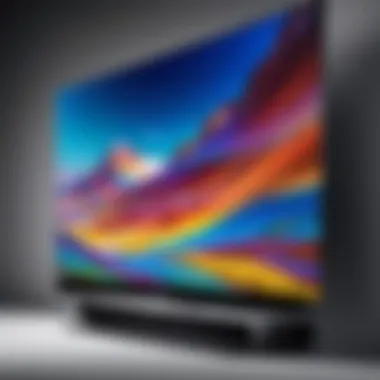
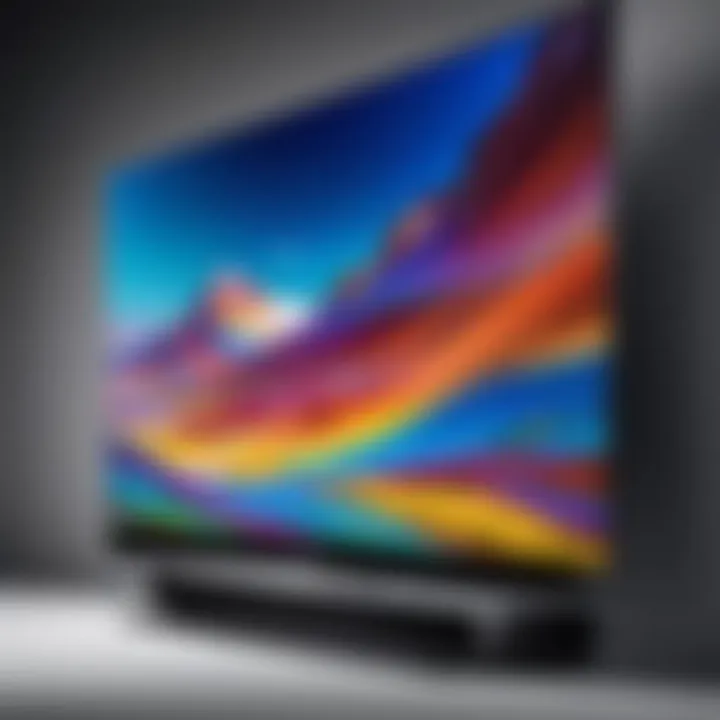
The landscape of OLED technology in television displays, particularly in Samsung's 4K offerings, is not devoid of hurdles. Despite the advancements and numerous benefits that OLED screens provide, there are several challenges that consumers and manufacturers must navigate. Understanding these challenges is crucial for making informed decisions when choosing a display.
Burn-in Issues
Burn-in is a significant concern for OLED technology. This phenomenon occurs when static images are displayed for extended periods, leading to permanent ghost images on the screen. Such issues can diminish the viewing experience, particularly for users who watch news channels with logos or play video games with static user interface elements. For consumers, it raises questions about usage patterns and best practices to mitigate burn-in.
- Prevention Techniques: Users can employ various strategies to prevent burn-in, such as:
- Avoiding Static Images: Regularly changing channels or moving the content on-screen can help reduce risk.
- Utilizing Screen Savers: Setting up screen savers during inactivity can be beneficial.
- Adjusting Display Settings: Features like pixel shifting or using lower brightness settings could also help mitigate the problem.
Despite these preventive steps, the inherent risk associated with burn-in remains a concern for many users.
Longevity and Durability Concerns
Another critical issue relating to OLED technology is longevity. Compared to other technologies, such as LED-LCD, OLED displays may exhibit reduced lifespan under certain conditions. The organic compounds used in these displays degrade over time, potentially leading to color distortion and reduced brightness levels. Consequently, users may find themselves needing to replace their devices sooner than they would with alternative technologies.
Factors affecting longevity include:
- Usage Patterns: Heavy usage, particularly with high brightness settings, can accelerate degradation.
- Environmental Conditions: Excessive heat and humidity can also impact the display's durability.
Cost Implications for Consumers
The premium quality associated with OLED technology typically comes with a higher price tag. This cost can be prohibitive for many consumers, particularly when considering the potential need for replacements or repairs should issues arise. Samsung's 4K OLED TVs are no exception, often being priced above their LED-LCD counterparts.
- Price vs. Value Consideration: While the visual quality of OLED is remarkable, potential buyers must weigh this benefit against the higher costs involved. Factors to consider include:
- Initial Investment: Upfront costs can deter some buyers.
- Long-term Worth: Consideration for the longevity of the device is vital.
- Performance Guarantees: Warranty and support options may affect the total cost of ownership.
In summary, while OLED technology offers numerous benefits, potential buyers must also carefully assess these challenges. Understanding how the burn-in issue, durability considerations, and cost implications play into the overall user experience is critical. This knowledge helps consumers make informed choices aligning with their preferences and usage habits.
User Experience and Reviews
User experience and reviews play a crucial role in understanding the impact of Samsung's 4K OLED televisions. These aspects provide insights into how consumers interact with the technology and what they value in their viewing experience. By examining user feedback, we can identify real-time performance outcomes, satisfaction levels, and potential areas for improvement in these products.
Consumer Feedback on Performance
Consumer feedback showcases various performance aspects of Samsung's 4K OLED TVs. Many users highlight color accuracy as a standout feature. With OLED's ability to produce deep blacks and vibrant colors, viewers often express astonishment at the visual quality.
In terms of picture clarity, users appreciate the high resolution, which allows for precise details. Many users have reported that watching sports or fast-paced movies is more enjoyable due to the exceptional motion handling capabilities of these displays.
Additionally, feedback often points to the user-friendly interface of the Samsung smart TV platform. Users find it intuitive, making it easier to navigate various apps and settings.
However, some users have raised concerns about burn-in, a well-known issue with OLED screens. They noted the importance of brand strategies in mitigating this problem through software updates and usage recommendations. Users often emphasize that knowing how to care for their OLED screen enhances their overall experience.
Comparative User Satisfaction
When comparing user satisfaction across different brands, Samsung's OLED offerings often rank high. Many users state that the combination of design and performance sets Samsung apart from alternatives like LG or Sony. While LG has established itself as a strong competitor in OLED technology, some Samsung users feel that Samsung's unique features, such as its Tizen OS, provide a more cohesive user experience.
Additionally, specific product lines, such as the Samsung S95B, have garnered positive reviews for blending aesthetics with performance. Users frequently mention the sleek design, which complements modern home environments, as an added bonus alongside superior visual quality.
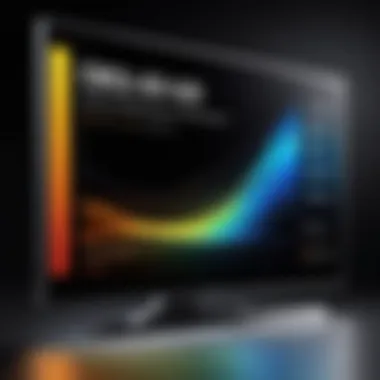
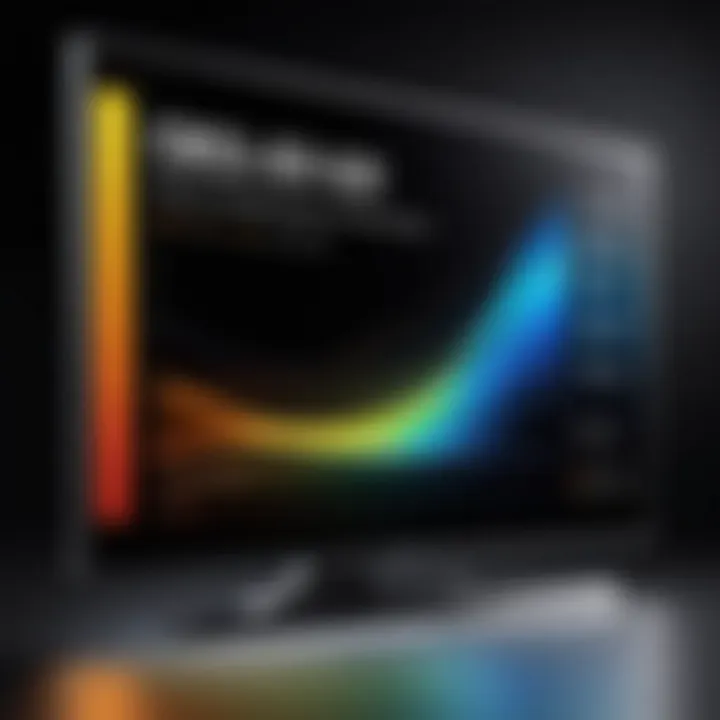
Overall, users tend to indicate a high level of satisfaction with Samsung's OLED products, pointing to enhanced cinematic experiences and ease of use as primary factors. Often, consumers express willingness to recommend these TVs based on their satisfactory experiences, affirming the brand's reputation in the OLED segment.
"Samsung's OLED technology has transformed my viewing experience. The colors just pop, and the design fits perfectly with my home decor."
— Anonymous user review
The informative nature of user reviews provides valuable insights that can aid potential customers in making informed decisions regarding their purchase. The consistent positive feedback reinforces Samsung's position in the competitive 4K OLED TV market.
Future Perspectives on OLED Technology
The landscape of display technologies is continuously evolving, and OLED stands at the precipice of groundbreaking advancements. Understanding the future perspectives of OLED technology, especially within Samsung's 4K offerings, is essential for both consumers and industry professionals. The ongoing evolution of this technology promises numerous enhancements that can redefine user experience, energy consumption, and visual fidelity.
As we transition into an era where visual quality is paramount, innovations in OLED technology will likely address existing challenges such as burn-in effects and durability issues. Emphasizing these future developments not only showcases progressive manufacturing techniques but also illuminates the commitment of companies like Samsung to enhance product reliability. This commitment is significant as it directly impacts consumer confidence and market dynamics.
Advancements in OLED Development
Recent advancements in OLED technology present a broad spectrum of improvements. Notably, these include:
- Improved Material Quality: Ongoing research is focusing on better organic compounds that enhance brightness and longevity.
- Panel Thickness Reductions: Innovations are allowing manufacturers to create thinner OLED panels without sacrificing image quality.
- Better Heat Management: New approaches in thermal regulation help mitigate potential damage and improve efficiency.
Samsung's investment in R&D plays a pivotal role in these advancements. By exploring materials like new phosphorescent compounds and advanced pixel technologies, the potential for producing even richer colors and deeper blacks is enormous. These developments could lead to televisions that not only compete with but outperform current market leaders.
Potential Market Trends
The future of OLED technology in Samsung's 4K offerings will likely align with several market trends, which include:
- Increased Adoption of Smart Features: Integration of AI and machine learning within displays to enhance user interactivity and content recommendations.
- Sustainable Manufacturing Practices: The industry is leaning towards environmentally friendly practices, affecting supply chains and production methods.
- Diverse Product Offerings: With enhanced capabilities, there's potential for a wider array of products catering to varying consumer needs, from budget models to premium offerings.
Market dynamics will also be influenced by rising competition, not just from traditional rivals but from emerging companies entering the OLED space. These trends indicate a competitive future, emphasizing the importance of adaptability and innovation in product offerings.
As OLED technology continues to evolve, Samsung's commitment to innovation could set the stage for the next wave of display excellence.
Closure
The conclusion of this article on OLED technology in Samsung’s 4K offerings is critical. It summarizes the essential points, provides clarity on the discussed topics, and reinforces the relevance of the examined features. Understanding OLED technology’s role in Samsung's 4K televisions is vital for both consumers and industry professionals.
Initiating from the analysis of technical specifications to user experiences, it becomes clear that Samsung has made significant strides in OLED integration. The findings indicate that Samsung's 4K OLED TVs not only excel in color accuracy but also showcase enhanced contrast ratios and energy efficiency. Each of these elements contributes to an overall better viewing experience, appealing to tech enthusiasts and casual viewers alike.
Another important aspect is the ongoing challenges facing OLED technology itself. Addressing issues like burn-in, longevity, and cost ensures that potential buyers are informed, promoting transparency in the market. For potential consumers, understanding these factors aids in making well-informed purchasing decisions, tailoring selections to specific needs and contexts.
"The developments in OLED technology not only improve Samsung’s product lineup but also set industry standards that competitors are eager to meet."
Finally, considering future trends and advancements in OLED technology can help anticipate market shifts. Keeping abreast of these elements can benefit professionals seeking to stay relevant in an evolving field. In summary, the convergence of performance, challenges, and future directions in this sector frames Samsung’s OLED offerings as a pivotal topic in contemporary display technology discussions.
Summary of Findings
This exploration culminates in a rich understanding of various aspects surrounding Samsung's OLED technology within its 4K television range. Key takeaways include:
- Outstanding visual performance with superior color representation and diminished motion blur.
- Innovative energy efficiency that not only appeals to environmentally-conscious consumers but also reduces operational costs.
- User feedback highlights a positive reception concerning overall satisfaction and performance metrics.
Additionally, acknowledging the challenges associated with burn-in and potential longevity issues allows consumers to grasp the complete landscape of OLED technology. By synthesizing all these findings, it is evident that Samsung is at the forefront of making OLED more mainstream and accessible while striving to overcome existing hurdles in the technology.
Final Thoughts on Samsung OLED 4K TVs
In the realm of home entertainment, Samsung's OLED 4K TVs stand out due to their robust technology. The blend of OLED expertise and Samsung’s renowned engineering creates devices that produce stunning visuals. Professionals and tech enthusiasts should appreciate how these televisions reflect the evolution of display technology.
The potential for future enhancements in OLED technology—such as better burn-in mitigation and improved manufacturing processes—remains promising. As Samsung continues to innovate, consumer interest will likely grow, ensuring sustained interest and investment within the OLED sector. For anyone considering a television purchase, Samsung's 4K OLED models present compelling options for high-quality home viewing experiences.



